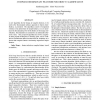Free Online Productivity Tools
i2Speak
i2Symbol
i2OCR
iTex2Img
iWeb2Print
iWeb2Shot
i2Type
iPdf2Split
iPdf2Merge
i2Bopomofo
i2Arabic
i2Style
i2Image
i2PDF
iLatex2Rtf
Sci2ools
ICIP
2008
IEEE
2008
IEEE
Complex discriminant features for object classification
A new algorithm for the design of complex features, to be used in the discriminant saliency approach to object classification, is presented. The algorithm consists of sequential rotations of an initial basis of simple features, so as to maximize the discriminant power of the feature set for image classification. Discrimination is measured in an information theoretic sense. The proposed algorithm has lower complexity than popular techniques for learning parts, and is evaluated on classification tasks from the PASCAL challenge. It is shown that complex features consistently outperform simple features.
Classification Tasks | Complex Features | Discriminant Power | Discriminant Saliency Approach | ICIP 2008 | Image Processing | Simple Features |
| Added | 20 Oct 2009 |
| Updated | 20 Oct 2009 |
| Type | Conference |
| Year | 2008 |
| Where | ICIP |
| Authors | Sunhyoung Han, Nuno Vasconcelos |
Comments (0)

